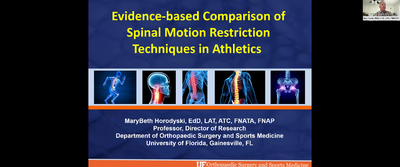Course Info (Description; Learning Objectives; Practice Gap; Clinical Bottom Line; Summary Conclusions)
Course Description
The presentation "Evidence-based Comparison of Spine Motion Restriction (SMR) Techniques in Athletics" will cover various learning objectives related to spinal motion restriction and immobilization in athletes. Attendees will learn the difference between spinal motion restriction and immobilization, and the decision-making process components between different healthcare providers for activating spinal motion restriction in spine-injured athletes. Additionally, the presentation will compare current evidenced-based best practices for on-field equipment removal and suggest future protocols. Attendees will identify evidence-based practices for selecting extrication equipment and transfers. Lastly, the presentation will compare current best practices for spine board use and potential future protocols. Overall, the presentation will provide a comprehensive understanding of SMR techniques in athletics, with a focus on evidence-based practices and recent research.
BOC Domains of Athletic Training:
-
Domain I - Risk Reduction, Wellness, and Health Literacy
- Domain II - Assessment, Evaluation and Diagnosis
-
Domain Ill - Critical Incident Management
Practice Gap:
Despite the availability of evidence-based guidelines on spinal motion restriction (SMR) techniques in athletics, there is a gap in knowledge and implementation of these guidelines among athletic trainers and other healthcare providers. Specifically, there is a need for improved understanding and decision-making processes related to activating SMR in spine-injured athletes, selecting appropriate extrication equipment and transfer methods, and on-field equipment removal. To improve outcomes for spine-injured athletes, it is essential for healthcare providers to prioritize evidence-based practices and stay up to date with the latest research in SMR techniques in athletics.
Learning Objectives:
Upon completion of this course, participants will be able to:
- Explain the difference between spinal motion restriction and spinal immobilization.
- Assess and compare the components of the decision-making process between different healthcare providers for activating spinal motion restriction for the spine-injured athlete.
- Compare and contrast differences between current evidenced-based best practices for on-field removal of equipment for the spine-injured athlete and compose ideas that may add to future protocols.
- Identify evidence-based practices for the selection of the different types of extrication equipment and transfers (log roll, multi-person, straddle lift‐and‐slide, scoop stretcher, vacuum mattress).
- Compare differences between current evidenced-based best practices for the use of a spine board and potential future protocols.
Clinical Bottom Line:
After reviewing the current evidence-based practices and research related to spinal motion restriction (SMR) techniques in athletics, the clinical bottom line is that healthcare providers should prioritize evidence-based decision-making processes for activating SMR in spine-injured athletes. Best practices for on-field equipment removal and selection of extrication equipment are based on the latest evidence-based guidelines. It is also essential to compare current best practices for spine board use and consider potential future protocols. Healthcare providers should stay up to date with the latest research to ensure the highest level of care for spine-injured athletes.
Summary Conclusions:
- Spinal motion restriction (SMR) is a critical technique for healthcare providers to use when treating spine-injured athletes, and evidence-based decision-making is essential to ensure the highest level of care.
- The selection of extrication equipment and transfer methods, such as log roll, multi-person, straddle lift-and-slide, scoop stretcher, and vacuum mattress, should be based on the latest evidence-based guidelines to improve outcomes for spine-injured athletes.
- On-field equipment removal is a challenging aspect of SMR, and healthcare providers must follow current evidenced-based best practices while considering potential future protocols.
- Understanding the differences between spinal motion restriction and immobilization is crucial to ensure that healthcare providers implement the correct technique for spine-injured athletes.
- Staying up to date with the latest research on SMR techniques in athletics is vital for healthcare providers to provide the highest level of care for spine-injured athletes.


